Financial Analysis and Management Project Report: AB plc Case Study
VerifiedAdded on 2020/04/21
|12
|4202
|45
Project
AI Summary
This project report offers a financial analysis of AB plc, focusing on fund-raising strategies to acquire an unlisted company. The report explores various methods, including equity financing, debenture financing, term loans from banks and financial institutions, and asset securitization. It examines the advantages and disadvantages of each approach, considering factors like risk, cost, and impact on the company's capital structure. The analysis includes a discussion of financing and investment decisions, providing recommendations to AB plc on the most suitable fund-raising options to achieve its acquisition goals. The report emphasizes the importance of financial management and the implications of different funding sources on the company's financial health and future prospects. The report provides a detailed analysis of the case study and provides various recommendations to the company.
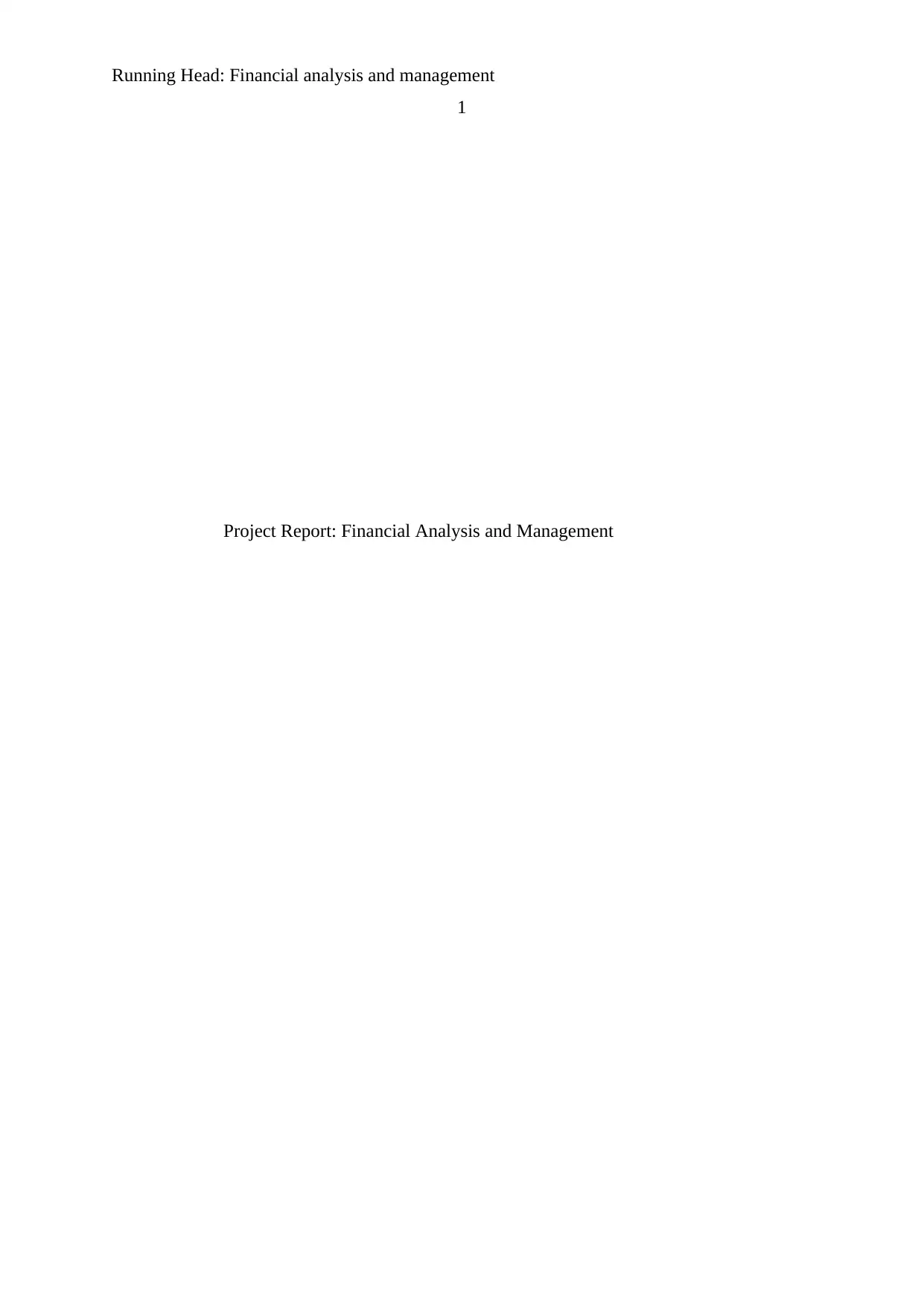
Running Head: Financial analysis and management
1
Project Report: Financial Analysis and Management
1
Project Report: Financial Analysis and Management
Paraphrase This Document
Need a fresh take? Get an instant paraphrase of this document with our AI Paraphraser
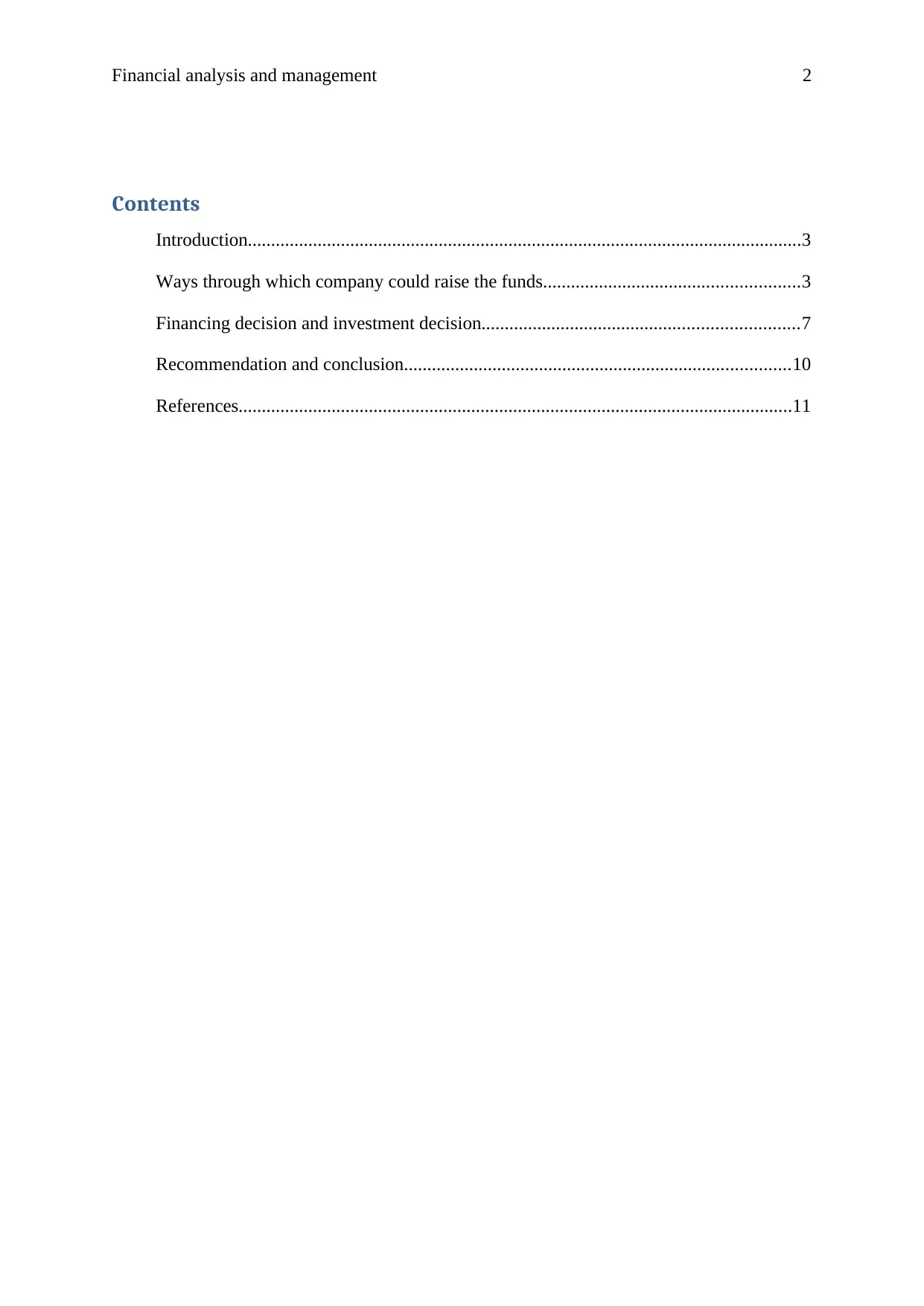
Financial analysis and management 2
Contents
Introduction.......................................................................................................................3
Ways through which company could raise the funds.......................................................3
Financing decision and investment decision....................................................................7
Recommendation and conclusion...................................................................................10
References.......................................................................................................................11
Contents
Introduction.......................................................................................................................3
Ways through which company could raise the funds.......................................................3
Financing decision and investment decision....................................................................7
Recommendation and conclusion...................................................................................10
References.......................................................................................................................11
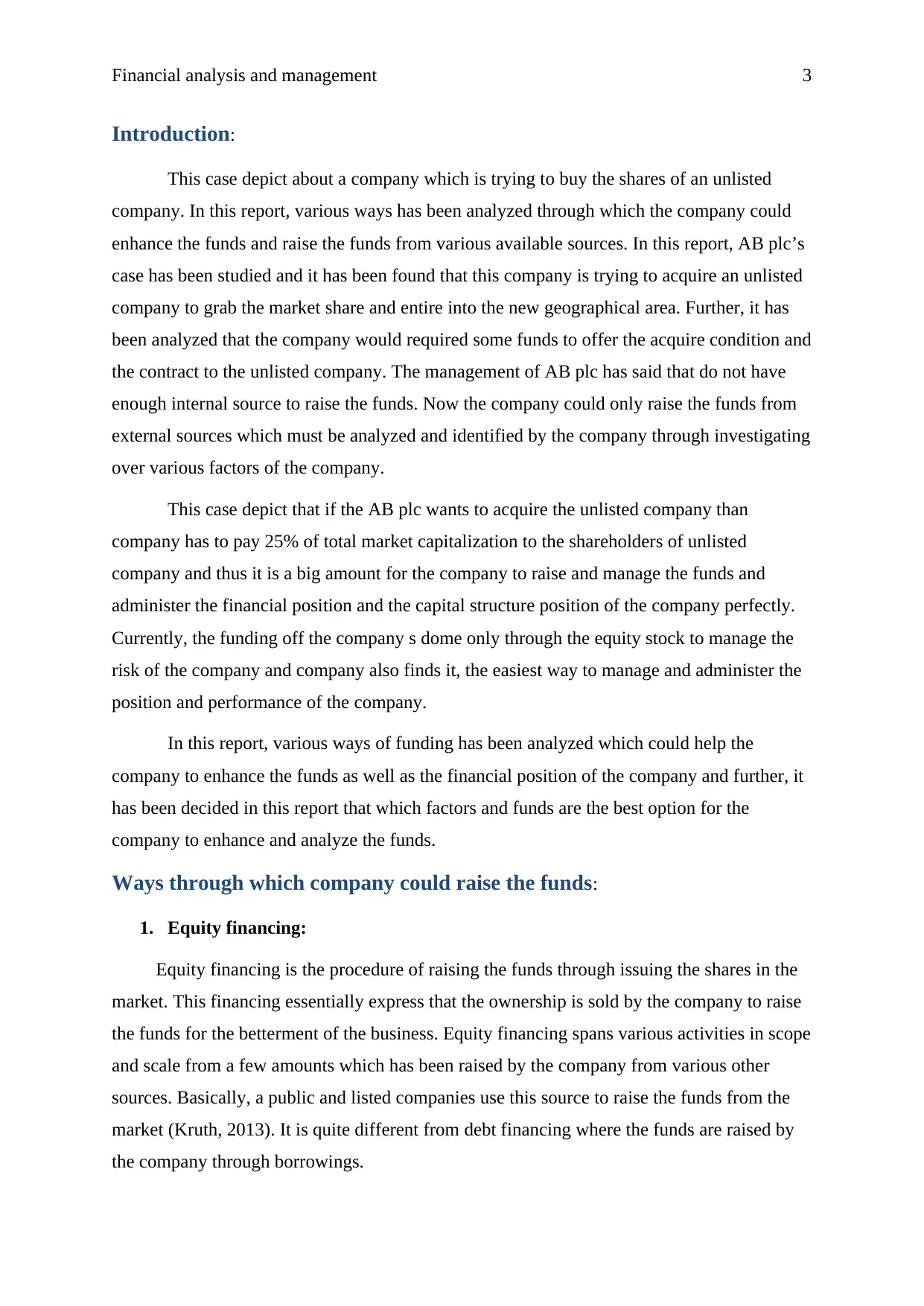
Financial analysis and management 3
Introduction:
This case depict about a company which is trying to buy the shares of an unlisted
company. In this report, various ways has been analyzed through which the company could
enhance the funds and raise the funds from various available sources. In this report, AB plc’s
case has been studied and it has been found that this company is trying to acquire an unlisted
company to grab the market share and entire into the new geographical area. Further, it has
been analyzed that the company would required some funds to offer the acquire condition and
the contract to the unlisted company. The management of AB plc has said that do not have
enough internal source to raise the funds. Now the company could only raise the funds from
external sources which must be analyzed and identified by the company through investigating
over various factors of the company.
This case depict that if the AB plc wants to acquire the unlisted company than
company has to pay 25% of total market capitalization to the shareholders of unlisted
company and thus it is a big amount for the company to raise and manage the funds and
administer the financial position and the capital structure position of the company perfectly.
Currently, the funding off the company s dome only through the equity stock to manage the
risk of the company and company also finds it, the easiest way to manage and administer the
position and performance of the company.
In this report, various ways of funding has been analyzed which could help the
company to enhance the funds as well as the financial position of the company and further, it
has been decided in this report that which factors and funds are the best option for the
company to enhance and analyze the funds.
Ways through which company could raise the funds:
1. Equity financing:
Equity financing is the procedure of raising the funds through issuing the shares in the
market. This financing essentially express that the ownership is sold by the company to raise
the funds for the betterment of the business. Equity financing spans various activities in scope
and scale from a few amounts which has been raised by the company from various other
sources. Basically, a public and listed companies use this source to raise the funds from the
market (Kruth, 2013). It is quite different from debt financing where the funds are raised by
the company through borrowings.
Introduction:
This case depict about a company which is trying to buy the shares of an unlisted
company. In this report, various ways has been analyzed through which the company could
enhance the funds and raise the funds from various available sources. In this report, AB plc’s
case has been studied and it has been found that this company is trying to acquire an unlisted
company to grab the market share and entire into the new geographical area. Further, it has
been analyzed that the company would required some funds to offer the acquire condition and
the contract to the unlisted company. The management of AB plc has said that do not have
enough internal source to raise the funds. Now the company could only raise the funds from
external sources which must be analyzed and identified by the company through investigating
over various factors of the company.
This case depict that if the AB plc wants to acquire the unlisted company than
company has to pay 25% of total market capitalization to the shareholders of unlisted
company and thus it is a big amount for the company to raise and manage the funds and
administer the financial position and the capital structure position of the company perfectly.
Currently, the funding off the company s dome only through the equity stock to manage the
risk of the company and company also finds it, the easiest way to manage and administer the
position and performance of the company.
In this report, various ways of funding has been analyzed which could help the
company to enhance the funds as well as the financial position of the company and further, it
has been decided in this report that which factors and funds are the best option for the
company to enhance and analyze the funds.
Ways through which company could raise the funds:
1. Equity financing:
Equity financing is the procedure of raising the funds through issuing the shares in the
market. This financing essentially express that the ownership is sold by the company to raise
the funds for the betterment of the business. Equity financing spans various activities in scope
and scale from a few amounts which has been raised by the company from various other
sources. Basically, a public and listed companies use this source to raise the funds from the
market (Kruth, 2013). It is quite different from debt financing where the funds are raised by
the company through borrowings.
⊘ This is a preview!⊘
Do you want full access?
Subscribe today to unlock all pages.

Trusted by 1+ million students worldwide
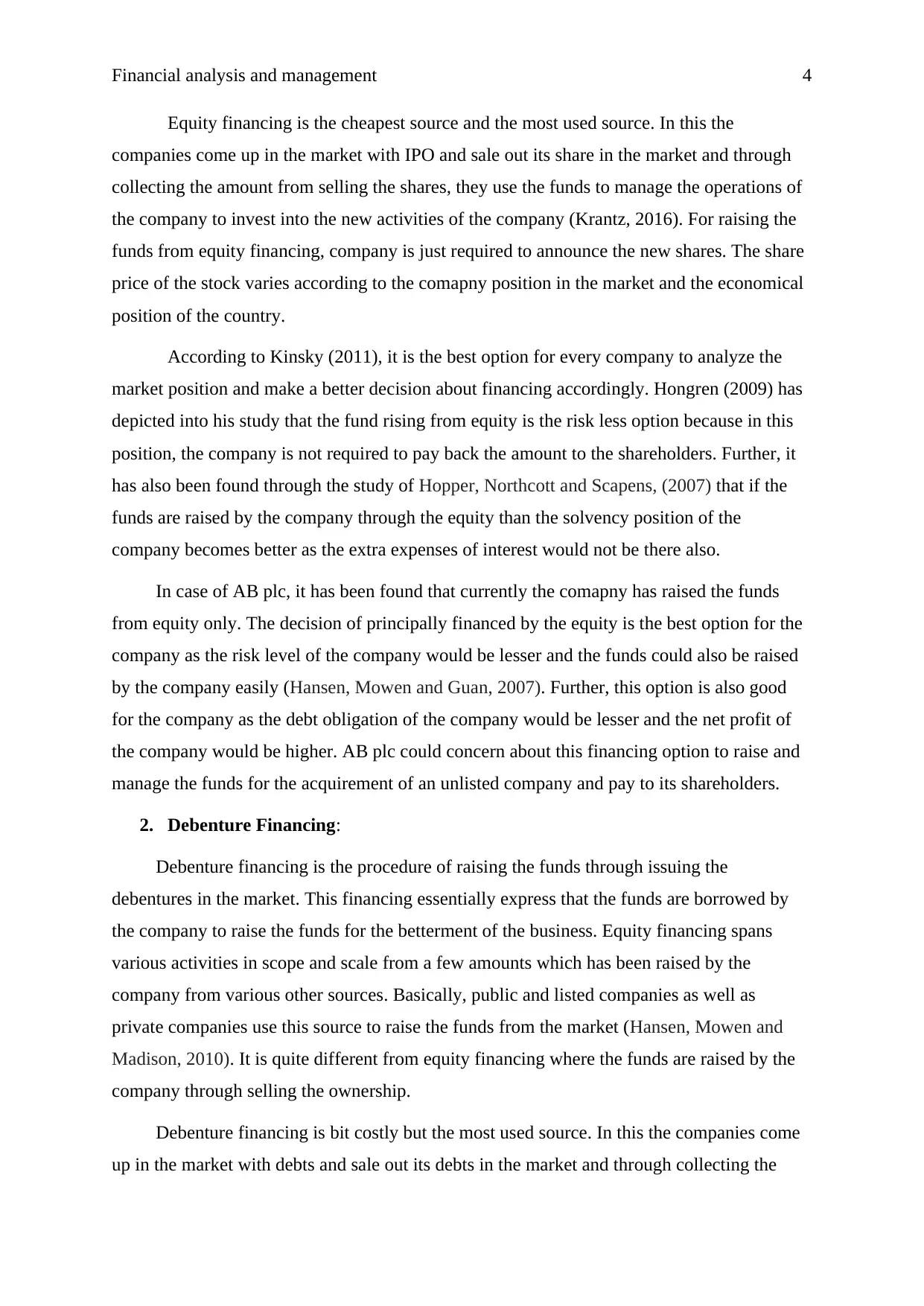
Financial analysis and management 4
Equity financing is the cheapest source and the most used source. In this the
companies come up in the market with IPO and sale out its share in the market and through
collecting the amount from selling the shares, they use the funds to manage the operations of
the company to invest into the new activities of the company (Krantz, 2016). For raising the
funds from equity financing, company is just required to announce the new shares. The share
price of the stock varies according to the comapny position in the market and the economical
position of the country.
According to Kinsky (2011), it is the best option for every company to analyze the
market position and make a better decision about financing accordingly. Hongren (2009) has
depicted into his study that the fund rising from equity is the risk less option because in this
position, the company is not required to pay back the amount to the shareholders. Further, it
has also been found through the study of Hopper, Northcott and Scapens, (2007) that if the
funds are raised by the company through the equity than the solvency position of the
company becomes better as the extra expenses of interest would not be there also.
In case of AB plc, it has been found that currently the comapny has raised the funds
from equity only. The decision of principally financed by the equity is the best option for the
company as the risk level of the company would be lesser and the funds could also be raised
by the company easily (Hansen, Mowen and Guan, 2007). Further, this option is also good
for the company as the debt obligation of the company would be lesser and the net profit of
the company would be higher. AB plc could concern about this financing option to raise and
manage the funds for the acquirement of an unlisted company and pay to its shareholders.
2. Debenture Financing:
Debenture financing is the procedure of raising the funds through issuing the
debentures in the market. This financing essentially express that the funds are borrowed by
the company to raise the funds for the betterment of the business. Equity financing spans
various activities in scope and scale from a few amounts which has been raised by the
company from various other sources. Basically, public and listed companies as well as
private companies use this source to raise the funds from the market (Hansen, Mowen and
Madison, 2010). It is quite different from equity financing where the funds are raised by the
company through selling the ownership.
Debenture financing is bit costly but the most used source. In this the companies come
up in the market with debts and sale out its debts in the market and through collecting the
Equity financing is the cheapest source and the most used source. In this the
companies come up in the market with IPO and sale out its share in the market and through
collecting the amount from selling the shares, they use the funds to manage the operations of
the company to invest into the new activities of the company (Krantz, 2016). For raising the
funds from equity financing, company is just required to announce the new shares. The share
price of the stock varies according to the comapny position in the market and the economical
position of the country.
According to Kinsky (2011), it is the best option for every company to analyze the
market position and make a better decision about financing accordingly. Hongren (2009) has
depicted into his study that the fund rising from equity is the risk less option because in this
position, the company is not required to pay back the amount to the shareholders. Further, it
has also been found through the study of Hopper, Northcott and Scapens, (2007) that if the
funds are raised by the company through the equity than the solvency position of the
company becomes better as the extra expenses of interest would not be there also.
In case of AB plc, it has been found that currently the comapny has raised the funds
from equity only. The decision of principally financed by the equity is the best option for the
company as the risk level of the company would be lesser and the funds could also be raised
by the company easily (Hansen, Mowen and Guan, 2007). Further, this option is also good
for the company as the debt obligation of the company would be lesser and the net profit of
the company would be higher. AB plc could concern about this financing option to raise and
manage the funds for the acquirement of an unlisted company and pay to its shareholders.
2. Debenture Financing:
Debenture financing is the procedure of raising the funds through issuing the
debentures in the market. This financing essentially express that the funds are borrowed by
the company to raise the funds for the betterment of the business. Equity financing spans
various activities in scope and scale from a few amounts which has been raised by the
company from various other sources. Basically, public and listed companies as well as
private companies use this source to raise the funds from the market (Hansen, Mowen and
Madison, 2010). It is quite different from equity financing where the funds are raised by the
company through selling the ownership.
Debenture financing is bit costly but the most used source. In this the companies come
up in the market with debts and sale out its debts in the market and through collecting the
Paraphrase This Document
Need a fresh take? Get an instant paraphrase of this document with our AI Paraphraser
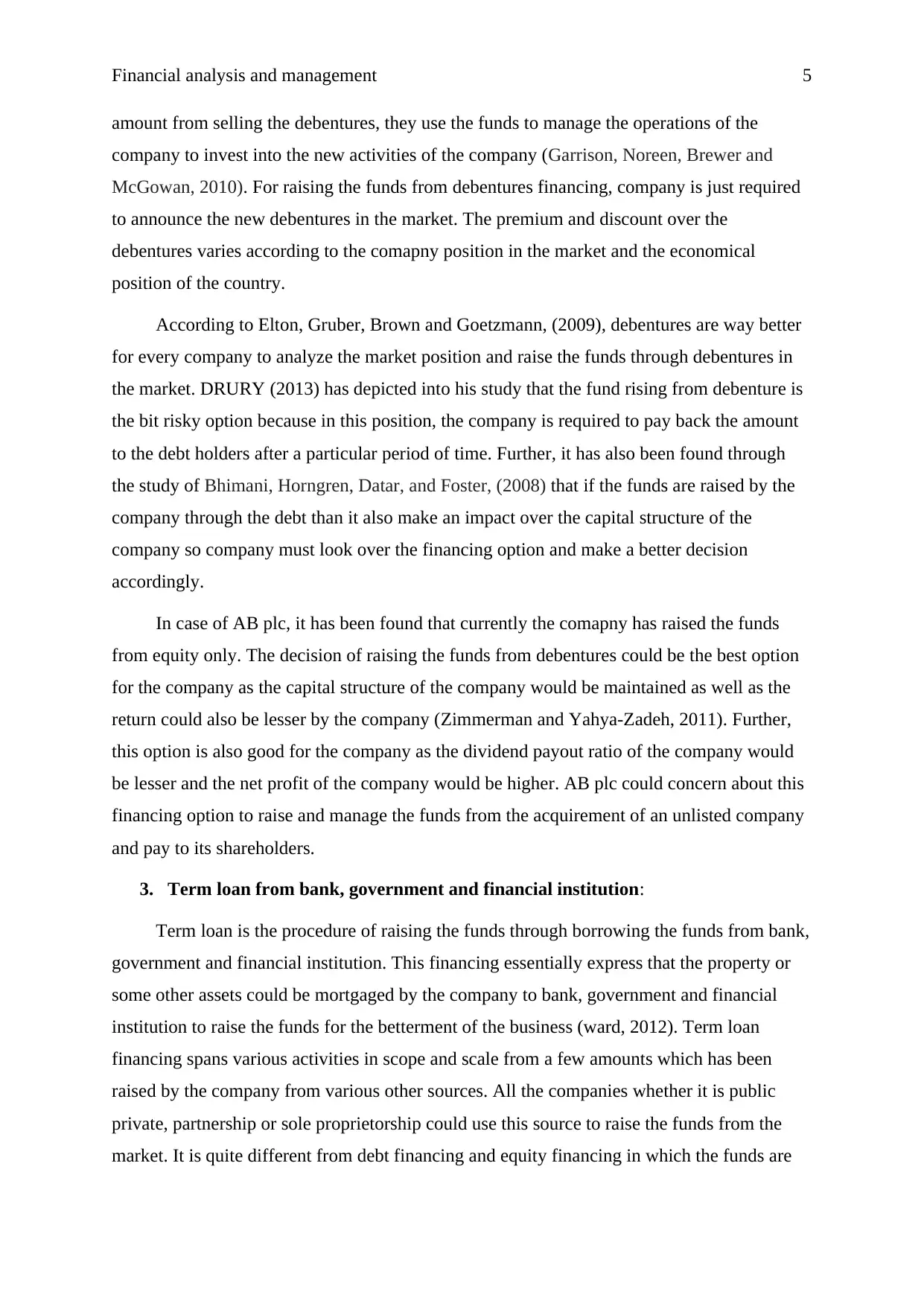
Financial analysis and management 5
amount from selling the debentures, they use the funds to manage the operations of the
company to invest into the new activities of the company (Garrison, Noreen, Brewer and
McGowan, 2010). For raising the funds from debentures financing, company is just required
to announce the new debentures in the market. The premium and discount over the
debentures varies according to the comapny position in the market and the economical
position of the country.
According to Elton, Gruber, Brown and Goetzmann, (2009), debentures are way better
for every company to analyze the market position and raise the funds through debentures in
the market. DRURY (2013) has depicted into his study that the fund rising from debenture is
the bit risky option because in this position, the company is required to pay back the amount
to the debt holders after a particular period of time. Further, it has also been found through
the study of Bhimani, Horngren, Datar, and Foster, (2008) that if the funds are raised by the
company through the debt than it also make an impact over the capital structure of the
company so company must look over the financing option and make a better decision
accordingly.
In case of AB plc, it has been found that currently the comapny has raised the funds
from equity only. The decision of raising the funds from debentures could be the best option
for the company as the capital structure of the company would be maintained as well as the
return could also be lesser by the company (Zimmerman and Yahya-Zadeh, 2011). Further,
this option is also good for the company as the dividend payout ratio of the company would
be lesser and the net profit of the company would be higher. AB plc could concern about this
financing option to raise and manage the funds from the acquirement of an unlisted company
and pay to its shareholders.
3. Term loan from bank, government and financial institution:
Term loan is the procedure of raising the funds through borrowing the funds from bank,
government and financial institution. This financing essentially express that the property or
some other assets could be mortgaged by the company to bank, government and financial
institution to raise the funds for the betterment of the business (ward, 2012). Term loan
financing spans various activities in scope and scale from a few amounts which has been
raised by the company from various other sources. All the companies whether it is public
private, partnership or sole proprietorship could use this source to raise the funds from the
market. It is quite different from debt financing and equity financing in which the funds are
amount from selling the debentures, they use the funds to manage the operations of the
company to invest into the new activities of the company (Garrison, Noreen, Brewer and
McGowan, 2010). For raising the funds from debentures financing, company is just required
to announce the new debentures in the market. The premium and discount over the
debentures varies according to the comapny position in the market and the economical
position of the country.
According to Elton, Gruber, Brown and Goetzmann, (2009), debentures are way better
for every company to analyze the market position and raise the funds through debentures in
the market. DRURY (2013) has depicted into his study that the fund rising from debenture is
the bit risky option because in this position, the company is required to pay back the amount
to the debt holders after a particular period of time. Further, it has also been found through
the study of Bhimani, Horngren, Datar, and Foster, (2008) that if the funds are raised by the
company through the debt than it also make an impact over the capital structure of the
company so company must look over the financing option and make a better decision
accordingly.
In case of AB plc, it has been found that currently the comapny has raised the funds
from equity only. The decision of raising the funds from debentures could be the best option
for the company as the capital structure of the company would be maintained as well as the
return could also be lesser by the company (Zimmerman and Yahya-Zadeh, 2011). Further,
this option is also good for the company as the dividend payout ratio of the company would
be lesser and the net profit of the company would be higher. AB plc could concern about this
financing option to raise and manage the funds from the acquirement of an unlisted company
and pay to its shareholders.
3. Term loan from bank, government and financial institution:
Term loan is the procedure of raising the funds through borrowing the funds from bank,
government and financial institution. This financing essentially express that the property or
some other assets could be mortgaged by the company to bank, government and financial
institution to raise the funds for the betterment of the business (ward, 2012). Term loan
financing spans various activities in scope and scale from a few amounts which has been
raised by the company from various other sources. All the companies whether it is public
private, partnership or sole proprietorship could use this source to raise the funds from the
market. It is quite different from debt financing and equity financing in which the funds are
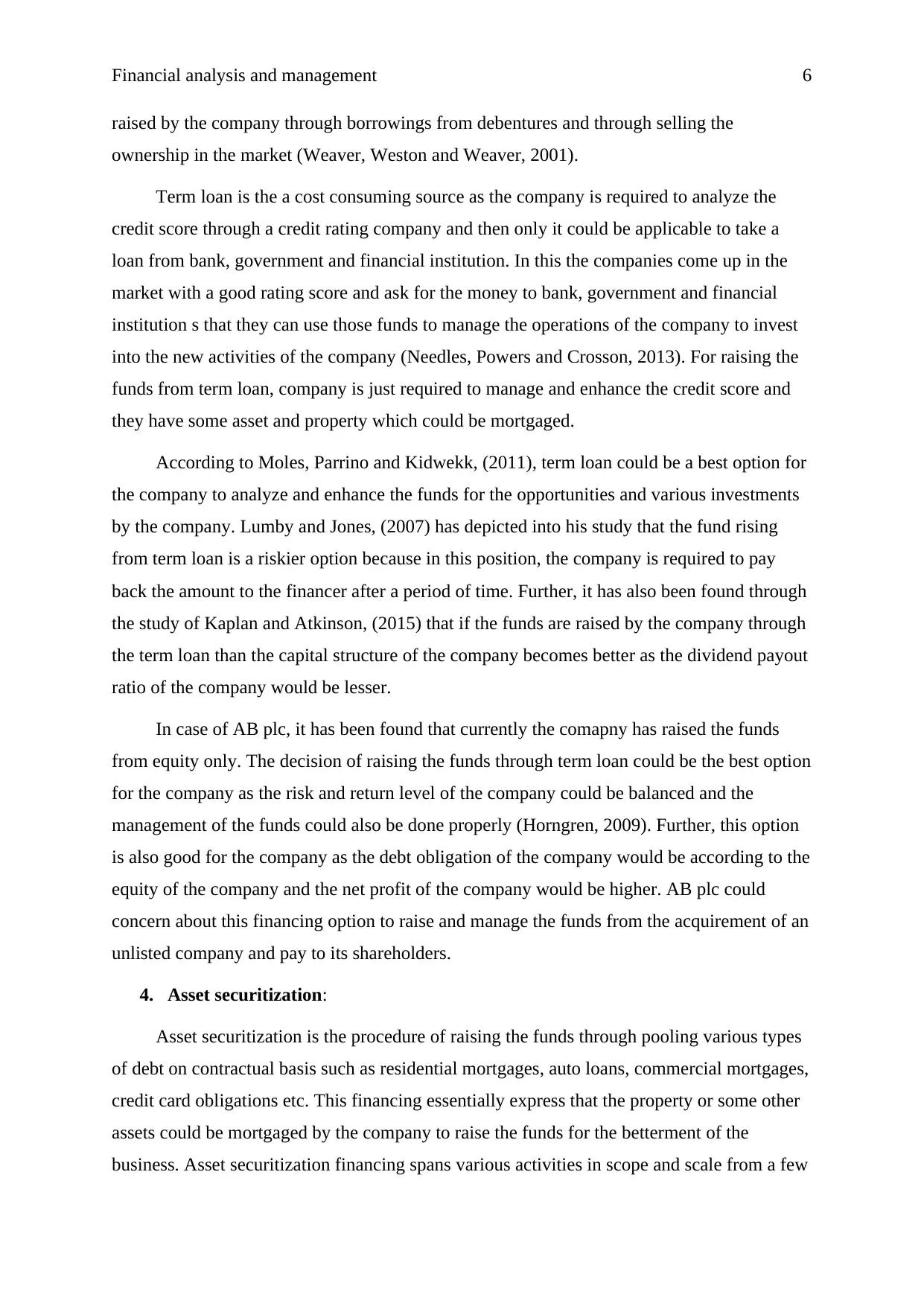
Financial analysis and management 6
raised by the company through borrowings from debentures and through selling the
ownership in the market (Weaver, Weston and Weaver, 2001).
Term loan is the a cost consuming source as the company is required to analyze the
credit score through a credit rating company and then only it could be applicable to take a
loan from bank, government and financial institution. In this the companies come up in the
market with a good rating score and ask for the money to bank, government and financial
institution s that they can use those funds to manage the operations of the company to invest
into the new activities of the company (Needles, Powers and Crosson, 2013). For raising the
funds from term loan, company is just required to manage and enhance the credit score and
they have some asset and property which could be mortgaged.
According to Moles, Parrino and Kidwekk, (2011), term loan could be a best option for
the company to analyze and enhance the funds for the opportunities and various investments
by the company. Lumby and Jones, (2007) has depicted into his study that the fund rising
from term loan is a riskier option because in this position, the company is required to pay
back the amount to the financer after a period of time. Further, it has also been found through
the study of Kaplan and Atkinson, (2015) that if the funds are raised by the company through
the term loan than the capital structure of the company becomes better as the dividend payout
ratio of the company would be lesser.
In case of AB plc, it has been found that currently the comapny has raised the funds
from equity only. The decision of raising the funds through term loan could be the best option
for the company as the risk and return level of the company could be balanced and the
management of the funds could also be done properly (Horngren, 2009). Further, this option
is also good for the company as the debt obligation of the company would be according to the
equity of the company and the net profit of the company would be higher. AB plc could
concern about this financing option to raise and manage the funds from the acquirement of an
unlisted company and pay to its shareholders.
4. Asset securitization:
Asset securitization is the procedure of raising the funds through pooling various types
of debt on contractual basis such as residential mortgages, auto loans, commercial mortgages,
credit card obligations etc. This financing essentially express that the property or some other
assets could be mortgaged by the company to raise the funds for the betterment of the
business. Asset securitization financing spans various activities in scope and scale from a few
raised by the company through borrowings from debentures and through selling the
ownership in the market (Weaver, Weston and Weaver, 2001).
Term loan is the a cost consuming source as the company is required to analyze the
credit score through a credit rating company and then only it could be applicable to take a
loan from bank, government and financial institution. In this the companies come up in the
market with a good rating score and ask for the money to bank, government and financial
institution s that they can use those funds to manage the operations of the company to invest
into the new activities of the company (Needles, Powers and Crosson, 2013). For raising the
funds from term loan, company is just required to manage and enhance the credit score and
they have some asset and property which could be mortgaged.
According to Moles, Parrino and Kidwekk, (2011), term loan could be a best option for
the company to analyze and enhance the funds for the opportunities and various investments
by the company. Lumby and Jones, (2007) has depicted into his study that the fund rising
from term loan is a riskier option because in this position, the company is required to pay
back the amount to the financer after a period of time. Further, it has also been found through
the study of Kaplan and Atkinson, (2015) that if the funds are raised by the company through
the term loan than the capital structure of the company becomes better as the dividend payout
ratio of the company would be lesser.
In case of AB plc, it has been found that currently the comapny has raised the funds
from equity only. The decision of raising the funds through term loan could be the best option
for the company as the risk and return level of the company could be balanced and the
management of the funds could also be done properly (Horngren, 2009). Further, this option
is also good for the company as the debt obligation of the company would be according to the
equity of the company and the net profit of the company would be higher. AB plc could
concern about this financing option to raise and manage the funds from the acquirement of an
unlisted company and pay to its shareholders.
4. Asset securitization:
Asset securitization is the procedure of raising the funds through pooling various types
of debt on contractual basis such as residential mortgages, auto loans, commercial mortgages,
credit card obligations etc. This financing essentially express that the property or some other
assets could be mortgaged by the company to raise the funds for the betterment of the
business. Asset securitization financing spans various activities in scope and scale from a few
⊘ This is a preview!⊘
Do you want full access?
Subscribe today to unlock all pages.

Trusted by 1+ million students worldwide
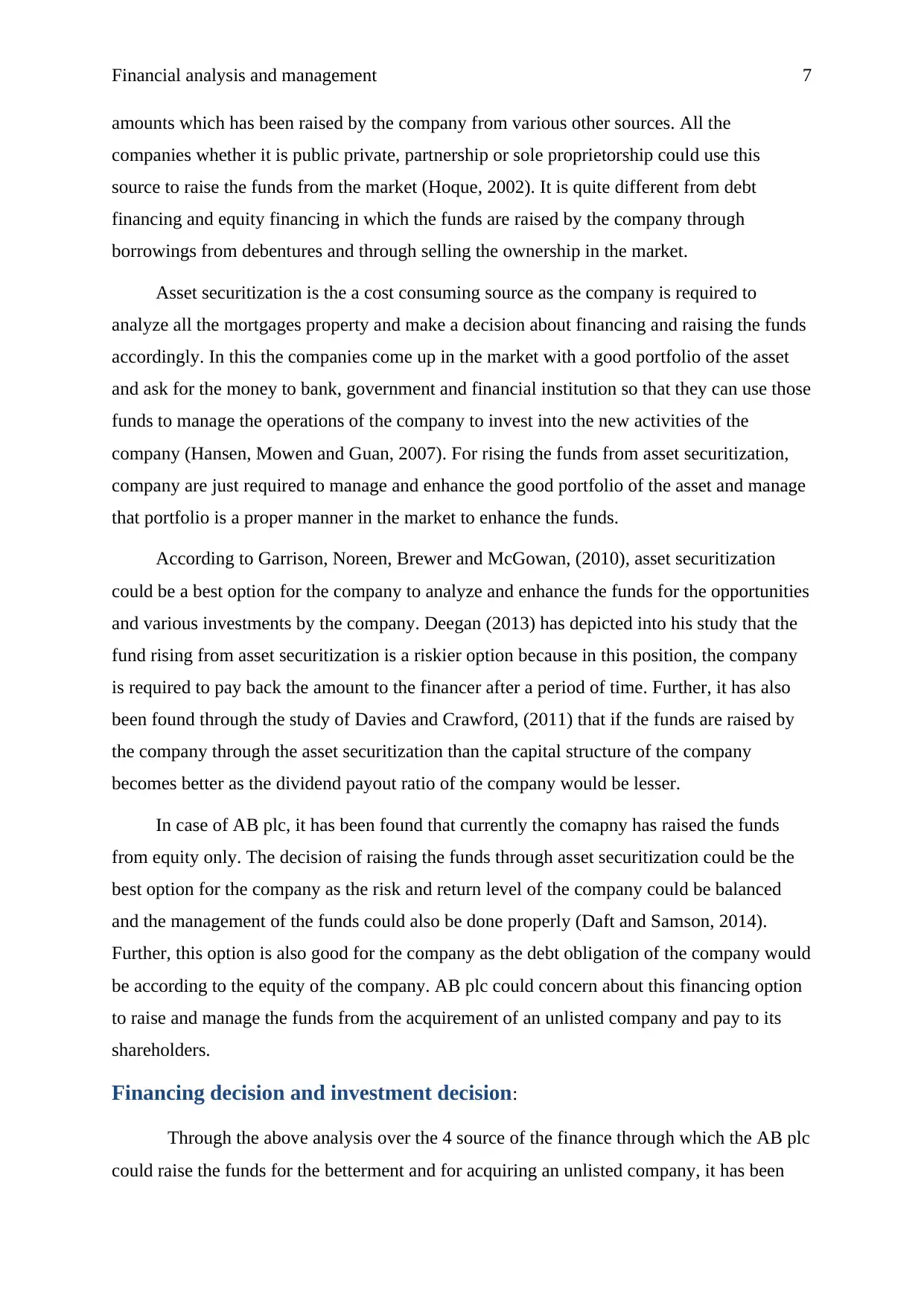
Financial analysis and management 7
amounts which has been raised by the company from various other sources. All the
companies whether it is public private, partnership or sole proprietorship could use this
source to raise the funds from the market (Hoque, 2002). It is quite different from debt
financing and equity financing in which the funds are raised by the company through
borrowings from debentures and through selling the ownership in the market.
Asset securitization is the a cost consuming source as the company is required to
analyze all the mortgages property and make a decision about financing and raising the funds
accordingly. In this the companies come up in the market with a good portfolio of the asset
and ask for the money to bank, government and financial institution so that they can use those
funds to manage the operations of the company to invest into the new activities of the
company (Hansen, Mowen and Guan, 2007). For rising the funds from asset securitization,
company are just required to manage and enhance the good portfolio of the asset and manage
that portfolio is a proper manner in the market to enhance the funds.
According to Garrison, Noreen, Brewer and McGowan, (2010), asset securitization
could be a best option for the company to analyze and enhance the funds for the opportunities
and various investments by the company. Deegan (2013) has depicted into his study that the
fund rising from asset securitization is a riskier option because in this position, the company
is required to pay back the amount to the financer after a period of time. Further, it has also
been found through the study of Davies and Crawford, (2011) that if the funds are raised by
the company through the asset securitization than the capital structure of the company
becomes better as the dividend payout ratio of the company would be lesser.
In case of AB plc, it has been found that currently the comapny has raised the funds
from equity only. The decision of raising the funds through asset securitization could be the
best option for the company as the risk and return level of the company could be balanced
and the management of the funds could also be done properly (Daft and Samson, 2014).
Further, this option is also good for the company as the debt obligation of the company would
be according to the equity of the company. AB plc could concern about this financing option
to raise and manage the funds from the acquirement of an unlisted company and pay to its
shareholders.
Financing decision and investment decision:
Through the above analysis over the 4 source of the finance through which the AB plc
could raise the funds for the betterment and for acquiring an unlisted company, it has been
amounts which has been raised by the company from various other sources. All the
companies whether it is public private, partnership or sole proprietorship could use this
source to raise the funds from the market (Hoque, 2002). It is quite different from debt
financing and equity financing in which the funds are raised by the company through
borrowings from debentures and through selling the ownership in the market.
Asset securitization is the a cost consuming source as the company is required to
analyze all the mortgages property and make a decision about financing and raising the funds
accordingly. In this the companies come up in the market with a good portfolio of the asset
and ask for the money to bank, government and financial institution so that they can use those
funds to manage the operations of the company to invest into the new activities of the
company (Hansen, Mowen and Guan, 2007). For rising the funds from asset securitization,
company are just required to manage and enhance the good portfolio of the asset and manage
that portfolio is a proper manner in the market to enhance the funds.
According to Garrison, Noreen, Brewer and McGowan, (2010), asset securitization
could be a best option for the company to analyze and enhance the funds for the opportunities
and various investments by the company. Deegan (2013) has depicted into his study that the
fund rising from asset securitization is a riskier option because in this position, the company
is required to pay back the amount to the financer after a period of time. Further, it has also
been found through the study of Davies and Crawford, (2011) that if the funds are raised by
the company through the asset securitization than the capital structure of the company
becomes better as the dividend payout ratio of the company would be lesser.
In case of AB plc, it has been found that currently the comapny has raised the funds
from equity only. The decision of raising the funds through asset securitization could be the
best option for the company as the risk and return level of the company could be balanced
and the management of the funds could also be done properly (Daft and Samson, 2014).
Further, this option is also good for the company as the debt obligation of the company would
be according to the equity of the company. AB plc could concern about this financing option
to raise and manage the funds from the acquirement of an unlisted company and pay to its
shareholders.
Financing decision and investment decision:
Through the above analysis over the 4 source of the finance through which the AB plc
could raise the funds for the betterment and for acquiring an unlisted company, it has been
Paraphrase This Document
Need a fresh take? Get an instant paraphrase of this document with our AI Paraphraser
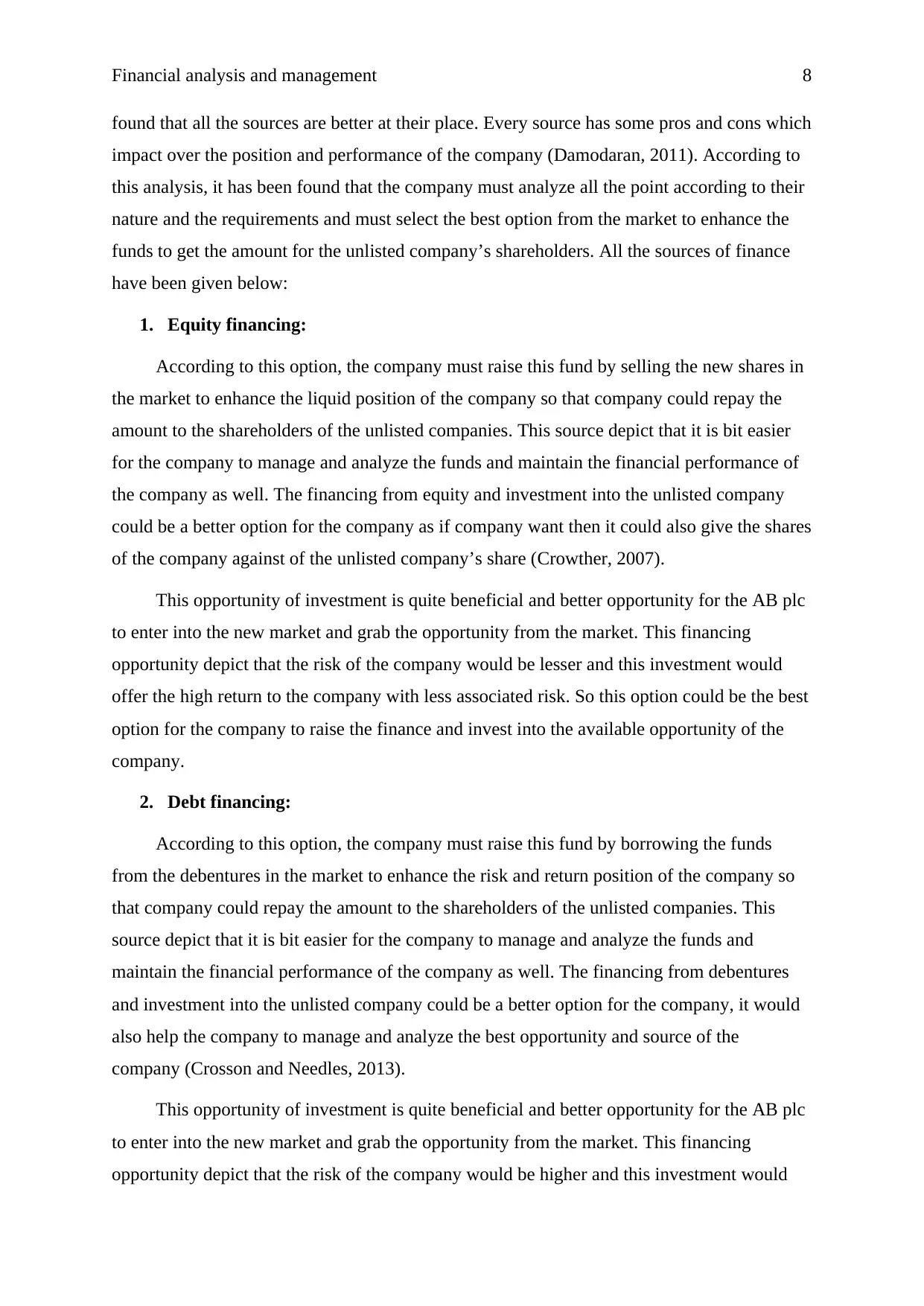
Financial analysis and management 8
found that all the sources are better at their place. Every source has some pros and cons which
impact over the position and performance of the company (Damodaran, 2011). According to
this analysis, it has been found that the company must analyze all the point according to their
nature and the requirements and must select the best option from the market to enhance the
funds to get the amount for the unlisted company’s shareholders. All the sources of finance
have been given below:
1. Equity financing:
According to this option, the company must raise this fund by selling the new shares in
the market to enhance the liquid position of the company so that company could repay the
amount to the shareholders of the unlisted companies. This source depict that it is bit easier
for the company to manage and analyze the funds and maintain the financial performance of
the company as well. The financing from equity and investment into the unlisted company
could be a better option for the company as if company want then it could also give the shares
of the company against of the unlisted company’s share (Crowther, 2007).
This opportunity of investment is quite beneficial and better opportunity for the AB plc
to enter into the new market and grab the opportunity from the market. This financing
opportunity depict that the risk of the company would be lesser and this investment would
offer the high return to the company with less associated risk. So this option could be the best
option for the company to raise the finance and invest into the available opportunity of the
company.
2. Debt financing:
According to this option, the company must raise this fund by borrowing the funds
from the debentures in the market to enhance the risk and return position of the company so
that company could repay the amount to the shareholders of the unlisted companies. This
source depict that it is bit easier for the company to manage and analyze the funds and
maintain the financial performance of the company as well. The financing from debentures
and investment into the unlisted company could be a better option for the company, it would
also help the company to manage and analyze the best opportunity and source of the
company (Crosson and Needles, 2013).
This opportunity of investment is quite beneficial and better opportunity for the AB plc
to enter into the new market and grab the opportunity from the market. This financing
opportunity depict that the risk of the company would be higher and this investment would
found that all the sources are better at their place. Every source has some pros and cons which
impact over the position and performance of the company (Damodaran, 2011). According to
this analysis, it has been found that the company must analyze all the point according to their
nature and the requirements and must select the best option from the market to enhance the
funds to get the amount for the unlisted company’s shareholders. All the sources of finance
have been given below:
1. Equity financing:
According to this option, the company must raise this fund by selling the new shares in
the market to enhance the liquid position of the company so that company could repay the
amount to the shareholders of the unlisted companies. This source depict that it is bit easier
for the company to manage and analyze the funds and maintain the financial performance of
the company as well. The financing from equity and investment into the unlisted company
could be a better option for the company as if company want then it could also give the shares
of the company against of the unlisted company’s share (Crowther, 2007).
This opportunity of investment is quite beneficial and better opportunity for the AB plc
to enter into the new market and grab the opportunity from the market. This financing
opportunity depict that the risk of the company would be lesser and this investment would
offer the high return to the company with less associated risk. So this option could be the best
option for the company to raise the finance and invest into the available opportunity of the
company.
2. Debt financing:
According to this option, the company must raise this fund by borrowing the funds
from the debentures in the market to enhance the risk and return position of the company so
that company could repay the amount to the shareholders of the unlisted companies. This
source depict that it is bit easier for the company to manage and analyze the funds and
maintain the financial performance of the company as well. The financing from debentures
and investment into the unlisted company could be a better option for the company, it would
also help the company to manage and analyze the best opportunity and source of the
company (Crosson and Needles, 2013).
This opportunity of investment is quite beneficial and better opportunity for the AB plc
to enter into the new market and grab the opportunity from the market. This financing
opportunity depict that the risk of the company would be higher and this investment would
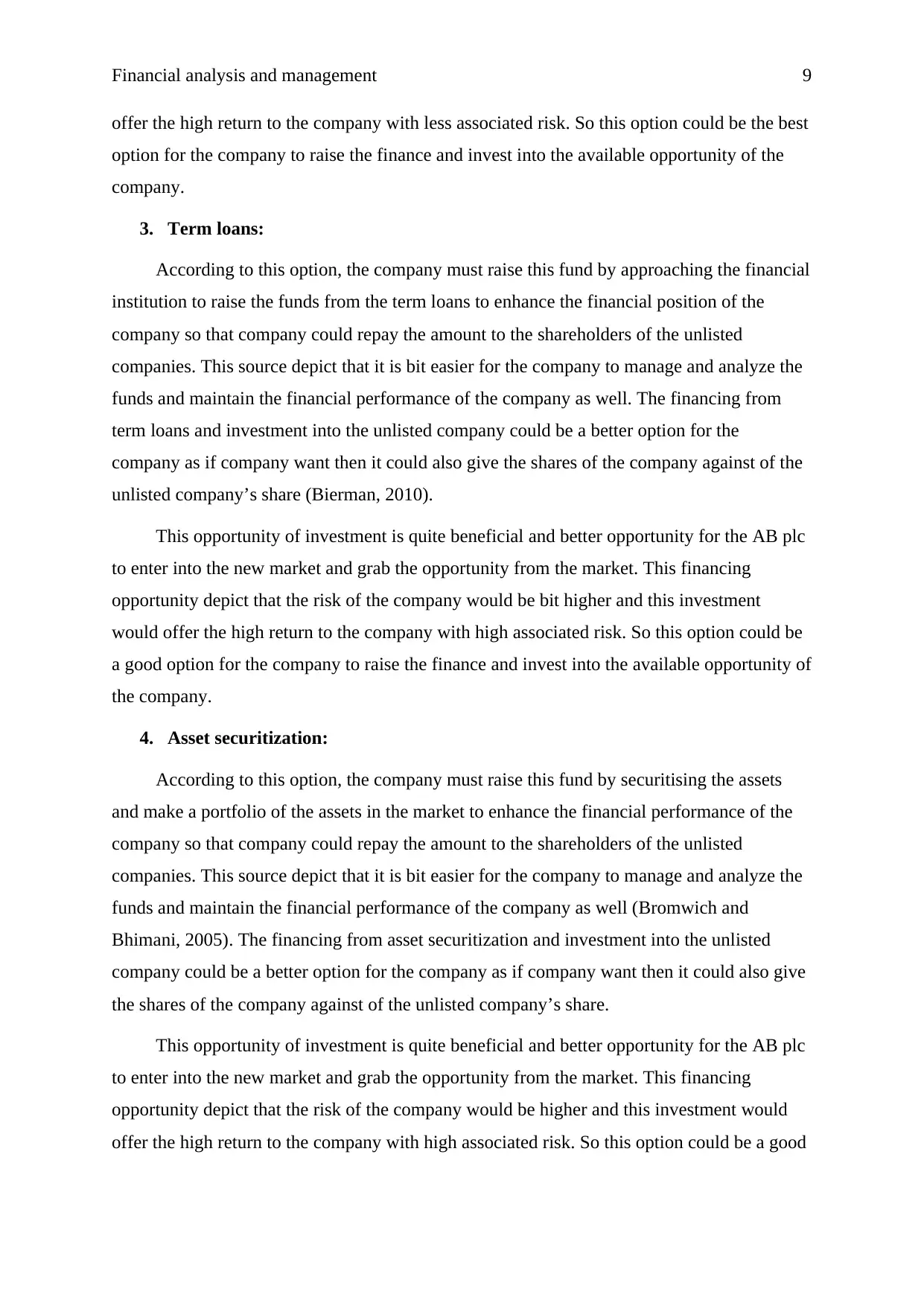
Financial analysis and management 9
offer the high return to the company with less associated risk. So this option could be the best
option for the company to raise the finance and invest into the available opportunity of the
company.
3. Term loans:
According to this option, the company must raise this fund by approaching the financial
institution to raise the funds from the term loans to enhance the financial position of the
company so that company could repay the amount to the shareholders of the unlisted
companies. This source depict that it is bit easier for the company to manage and analyze the
funds and maintain the financial performance of the company as well. The financing from
term loans and investment into the unlisted company could be a better option for the
company as if company want then it could also give the shares of the company against of the
unlisted company’s share (Bierman, 2010).
This opportunity of investment is quite beneficial and better opportunity for the AB plc
to enter into the new market and grab the opportunity from the market. This financing
opportunity depict that the risk of the company would be bit higher and this investment
would offer the high return to the company with high associated risk. So this option could be
a good option for the company to raise the finance and invest into the available opportunity of
the company.
4. Asset securitization:
According to this option, the company must raise this fund by securitising the assets
and make a portfolio of the assets in the market to enhance the financial performance of the
company so that company could repay the amount to the shareholders of the unlisted
companies. This source depict that it is bit easier for the company to manage and analyze the
funds and maintain the financial performance of the company as well (Bromwich and
Bhimani, 2005). The financing from asset securitization and investment into the unlisted
company could be a better option for the company as if company want then it could also give
the shares of the company against of the unlisted company’s share.
This opportunity of investment is quite beneficial and better opportunity for the AB plc
to enter into the new market and grab the opportunity from the market. This financing
opportunity depict that the risk of the company would be higher and this investment would
offer the high return to the company with high associated risk. So this option could be a good
offer the high return to the company with less associated risk. So this option could be the best
option for the company to raise the finance and invest into the available opportunity of the
company.
3. Term loans:
According to this option, the company must raise this fund by approaching the financial
institution to raise the funds from the term loans to enhance the financial position of the
company so that company could repay the amount to the shareholders of the unlisted
companies. This source depict that it is bit easier for the company to manage and analyze the
funds and maintain the financial performance of the company as well. The financing from
term loans and investment into the unlisted company could be a better option for the
company as if company want then it could also give the shares of the company against of the
unlisted company’s share (Bierman, 2010).
This opportunity of investment is quite beneficial and better opportunity for the AB plc
to enter into the new market and grab the opportunity from the market. This financing
opportunity depict that the risk of the company would be bit higher and this investment
would offer the high return to the company with high associated risk. So this option could be
a good option for the company to raise the finance and invest into the available opportunity of
the company.
4. Asset securitization:
According to this option, the company must raise this fund by securitising the assets
and make a portfolio of the assets in the market to enhance the financial performance of the
company so that company could repay the amount to the shareholders of the unlisted
companies. This source depict that it is bit easier for the company to manage and analyze the
funds and maintain the financial performance of the company as well (Bromwich and
Bhimani, 2005). The financing from asset securitization and investment into the unlisted
company could be a better option for the company as if company want then it could also give
the shares of the company against of the unlisted company’s share.
This opportunity of investment is quite beneficial and better opportunity for the AB plc
to enter into the new market and grab the opportunity from the market. This financing
opportunity depict that the risk of the company would be higher and this investment would
offer the high return to the company with high associated risk. So this option could be a good
⊘ This is a preview!⊘
Do you want full access?
Subscribe today to unlock all pages.

Trusted by 1+ million students worldwide
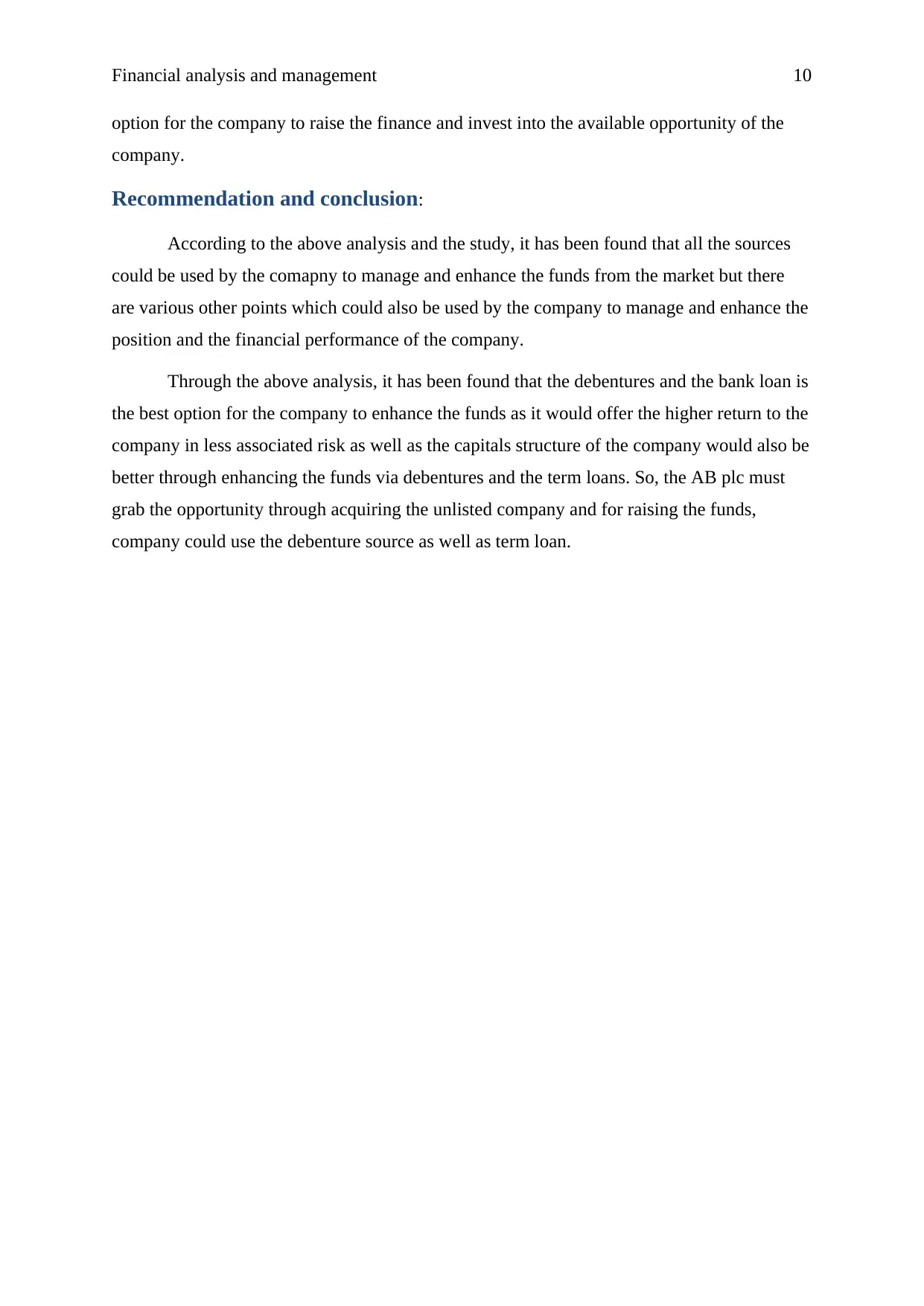
Financial analysis and management 10
option for the company to raise the finance and invest into the available opportunity of the
company.
Recommendation and conclusion:
According to the above analysis and the study, it has been found that all the sources
could be used by the comapny to manage and enhance the funds from the market but there
are various other points which could also be used by the company to manage and enhance the
position and the financial performance of the company.
Through the above analysis, it has been found that the debentures and the bank loan is
the best option for the company to enhance the funds as it would offer the higher return to the
company in less associated risk as well as the capitals structure of the company would also be
better through enhancing the funds via debentures and the term loans. So, the AB plc must
grab the opportunity through acquiring the unlisted company and for raising the funds,
company could use the debenture source as well as term loan.
option for the company to raise the finance and invest into the available opportunity of the
company.
Recommendation and conclusion:
According to the above analysis and the study, it has been found that all the sources
could be used by the comapny to manage and enhance the funds from the market but there
are various other points which could also be used by the company to manage and enhance the
position and the financial performance of the company.
Through the above analysis, it has been found that the debentures and the bank loan is
the best option for the company to enhance the funds as it would offer the higher return to the
company in less associated risk as well as the capitals structure of the company would also be
better through enhancing the funds via debentures and the term loans. So, the AB plc must
grab the opportunity through acquiring the unlisted company and for raising the funds,
company could use the debenture source as well as term loan.
Paraphrase This Document
Need a fresh take? Get an instant paraphrase of this document with our AI Paraphraser
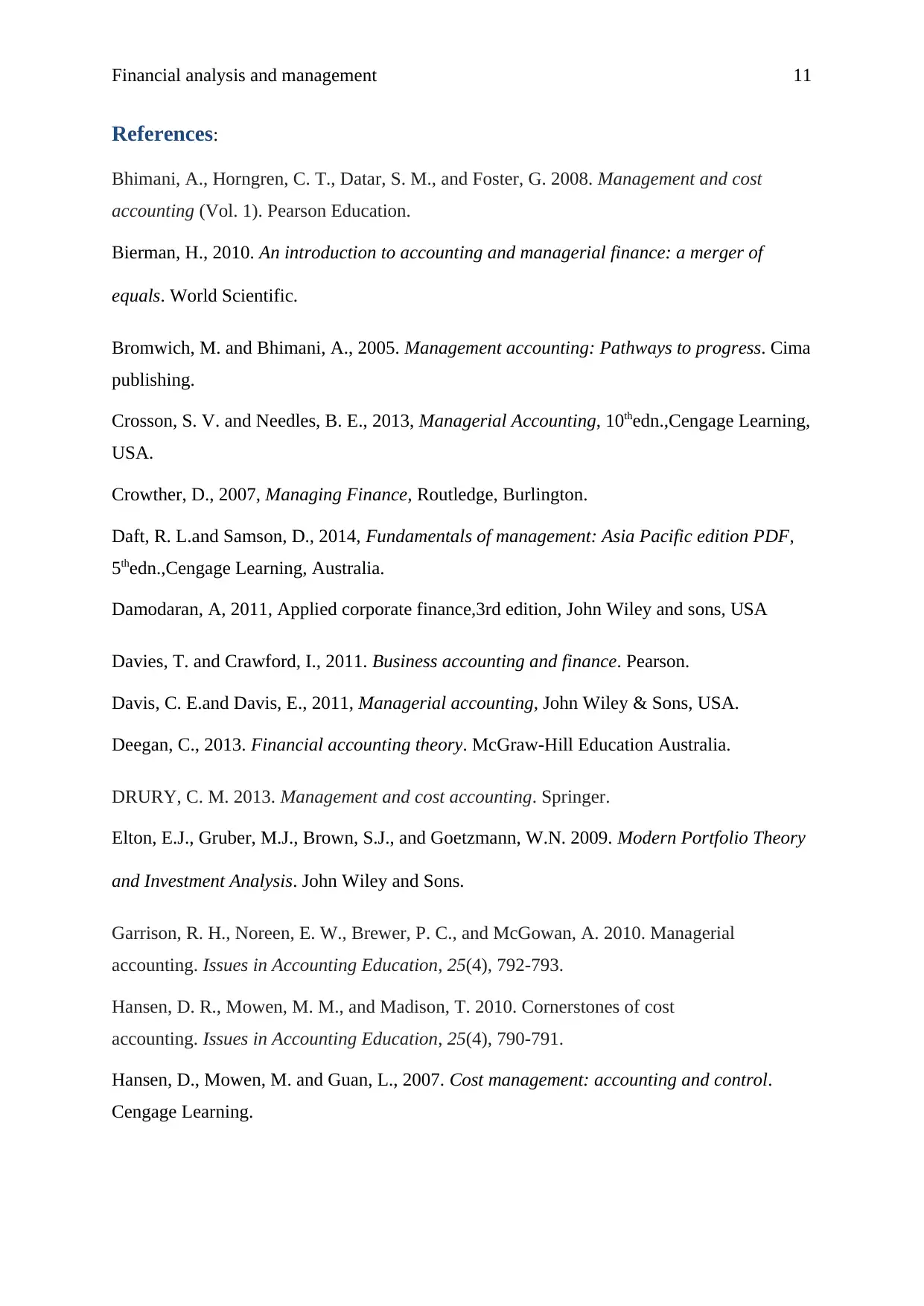
Financial analysis and management 11
References:
Bhimani, A., Horngren, C. T., Datar, S. M., and Foster, G. 2008. Management and cost
accounting (Vol. 1). Pearson Education.
Bierman, H., 2010. An introduction to accounting and managerial finance: a merger of
equals. World Scientific.
Bromwich, M. and Bhimani, A., 2005. Management accounting: Pathways to progress. Cima
publishing.
Crosson, S. V. and Needles, B. E., 2013, Managerial Accounting, 10thedn.,Cengage Learning,
USA.
Crowther, D., 2007, Managing Finance, Routledge, Burlington.
Daft, R. L.and Samson, D., 2014, Fundamentals of management: Asia Pacific edition PDF,
5thedn.,Cengage Learning, Australia.
Damodaran, A, 2011, Applied corporate finance,3rd edition, John Wiley and sons, USA
Davies, T. and Crawford, I., 2011. Business accounting and finance. Pearson.
Davis, C. E.and Davis, E., 2011, Managerial accounting, John Wiley & Sons, USA.
Deegan, C., 2013. Financial accounting theory. McGraw-Hill Education Australia.
DRURY, C. M. 2013. Management and cost accounting. Springer.
Elton, E.J., Gruber, M.J., Brown, S.J., and Goetzmann, W.N. 2009. Modern Portfolio Theory
and Investment Analysis. John Wiley and Sons.
Garrison, R. H., Noreen, E. W., Brewer, P. C., and McGowan, A. 2010. Managerial
accounting. Issues in Accounting Education, 25(4), 792-793.
Hansen, D. R., Mowen, M. M., and Madison, T. 2010. Cornerstones of cost
accounting. Issues in Accounting Education, 25(4), 790-791.
Hansen, D., Mowen, M. and Guan, L., 2007. Cost management: accounting and control.
Cengage Learning.
References:
Bhimani, A., Horngren, C. T., Datar, S. M., and Foster, G. 2008. Management and cost
accounting (Vol. 1). Pearson Education.
Bierman, H., 2010. An introduction to accounting and managerial finance: a merger of
equals. World Scientific.
Bromwich, M. and Bhimani, A., 2005. Management accounting: Pathways to progress. Cima
publishing.
Crosson, S. V. and Needles, B. E., 2013, Managerial Accounting, 10thedn.,Cengage Learning,
USA.
Crowther, D., 2007, Managing Finance, Routledge, Burlington.
Daft, R. L.and Samson, D., 2014, Fundamentals of management: Asia Pacific edition PDF,
5thedn.,Cengage Learning, Australia.
Damodaran, A, 2011, Applied corporate finance,3rd edition, John Wiley and sons, USA
Davies, T. and Crawford, I., 2011. Business accounting and finance. Pearson.
Davis, C. E.and Davis, E., 2011, Managerial accounting, John Wiley & Sons, USA.
Deegan, C., 2013. Financial accounting theory. McGraw-Hill Education Australia.
DRURY, C. M. 2013. Management and cost accounting. Springer.
Elton, E.J., Gruber, M.J., Brown, S.J., and Goetzmann, W.N. 2009. Modern Portfolio Theory
and Investment Analysis. John Wiley and Sons.
Garrison, R. H., Noreen, E. W., Brewer, P. C., and McGowan, A. 2010. Managerial
accounting. Issues in Accounting Education, 25(4), 792-793.
Hansen, D. R., Mowen, M. M., and Madison, T. 2010. Cornerstones of cost
accounting. Issues in Accounting Education, 25(4), 790-791.
Hansen, D., Mowen, M. and Guan, L., 2007. Cost management: accounting and control.
Cengage Learning.
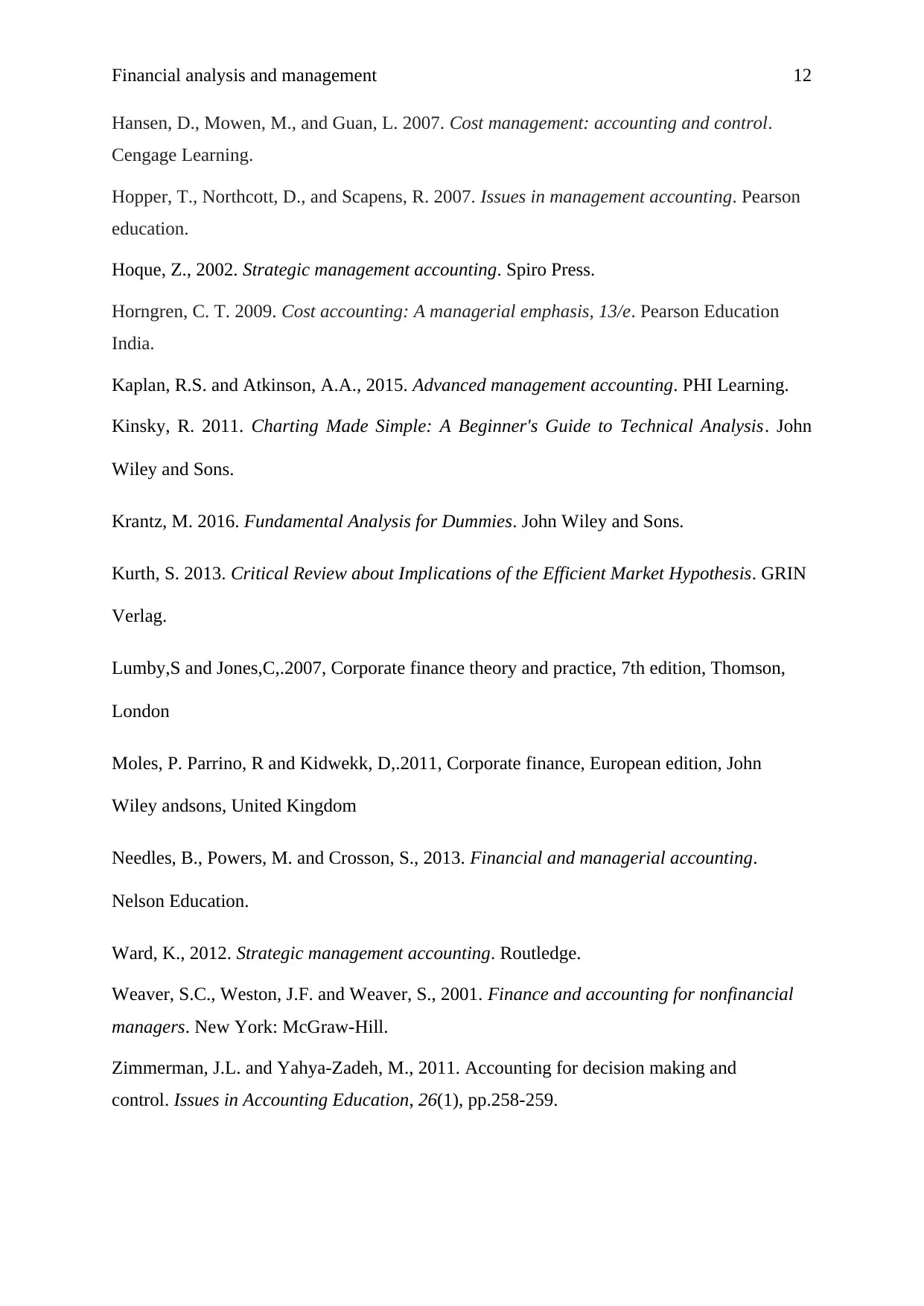
Financial analysis and management 12
Hansen, D., Mowen, M., and Guan, L. 2007. Cost management: accounting and control.
Cengage Learning.
Hopper, T., Northcott, D., and Scapens, R. 2007. Issues in management accounting. Pearson
education.
Hoque, Z., 2002. Strategic management accounting. Spiro Press.
Horngren, C. T. 2009. Cost accounting: A managerial emphasis, 13/e. Pearson Education
India.
Kaplan, R.S. and Atkinson, A.A., 2015. Advanced management accounting. PHI Learning.
Kinsky, R. 2011. Charting Made Simple: A Beginner's Guide to Technical Analysis. John
Wiley and Sons.
Krantz, M. 2016. Fundamental Analysis for Dummies. John Wiley and Sons.
Kurth, S. 2013. Critical Review about Implications of the Efficient Market Hypothesis. GRIN
Verlag.
Lumby,S and Jones,C,.2007, Corporate finance theory and practice, 7th edition, Thomson,
London
Moles, P. Parrino, R and Kidwekk, D,.2011, Corporate finance, European edition, John
Wiley andsons, United Kingdom
Needles, B., Powers, M. and Crosson, S., 2013. Financial and managerial accounting.
Nelson Education.
Ward, K., 2012. Strategic management accounting. Routledge.
Weaver, S.C., Weston, J.F. and Weaver, S., 2001. Finance and accounting for nonfinancial
managers. New York: McGraw-Hill.
Zimmerman, J.L. and Yahya-Zadeh, M., 2011. Accounting for decision making and
control. Issues in Accounting Education, 26(1), pp.258-259.
Hansen, D., Mowen, M., and Guan, L. 2007. Cost management: accounting and control.
Cengage Learning.
Hopper, T., Northcott, D., and Scapens, R. 2007. Issues in management accounting. Pearson
education.
Hoque, Z., 2002. Strategic management accounting. Spiro Press.
Horngren, C. T. 2009. Cost accounting: A managerial emphasis, 13/e. Pearson Education
India.
Kaplan, R.S. and Atkinson, A.A., 2015. Advanced management accounting. PHI Learning.
Kinsky, R. 2011. Charting Made Simple: A Beginner's Guide to Technical Analysis. John
Wiley and Sons.
Krantz, M. 2016. Fundamental Analysis for Dummies. John Wiley and Sons.
Kurth, S. 2013. Critical Review about Implications of the Efficient Market Hypothesis. GRIN
Verlag.
Lumby,S and Jones,C,.2007, Corporate finance theory and practice, 7th edition, Thomson,
London
Moles, P. Parrino, R and Kidwekk, D,.2011, Corporate finance, European edition, John
Wiley andsons, United Kingdom
Needles, B., Powers, M. and Crosson, S., 2013. Financial and managerial accounting.
Nelson Education.
Ward, K., 2012. Strategic management accounting. Routledge.
Weaver, S.C., Weston, J.F. and Weaver, S., 2001. Finance and accounting for nonfinancial
managers. New York: McGraw-Hill.
Zimmerman, J.L. and Yahya-Zadeh, M., 2011. Accounting for decision making and
control. Issues in Accounting Education, 26(1), pp.258-259.
⊘ This is a preview!⊘
Do you want full access?
Subscribe today to unlock all pages.

Trusted by 1+ million students worldwide
1 out of 12
Related Documents
Your All-in-One AI-Powered Toolkit for Academic Success.
+13062052269
info@desklib.com
Available 24*7 on WhatsApp / Email
![[object Object]](/_next/static/media/star-bottom.7253800d.svg)
Unlock your academic potential
Copyright © 2020–2025 A2Z Services. All Rights Reserved. Developed and managed by ZUCOL.





